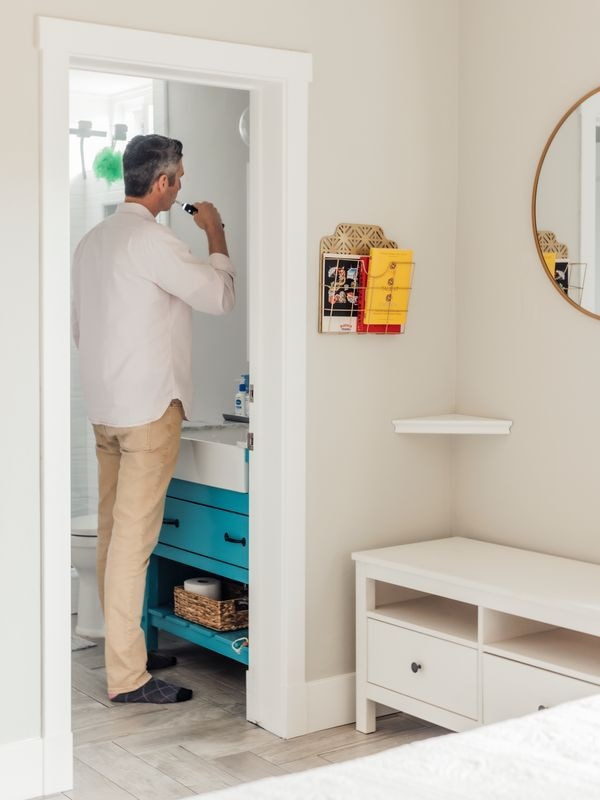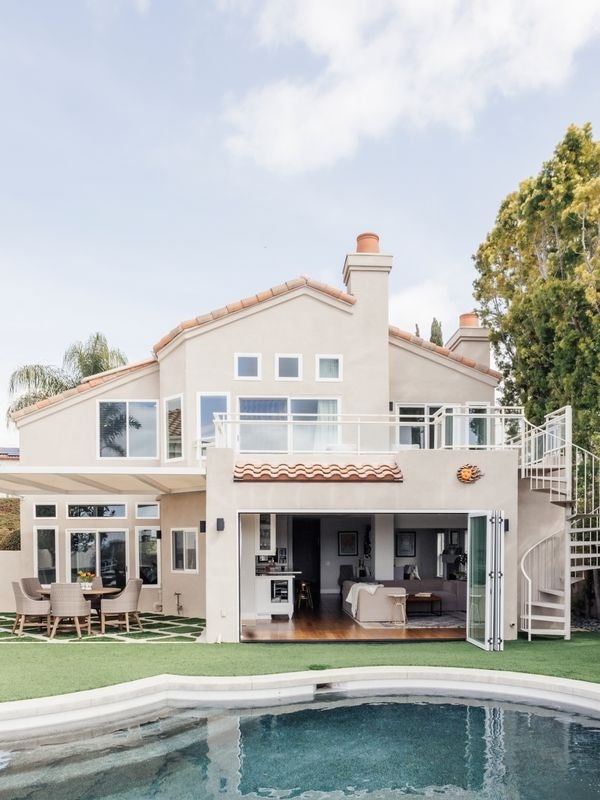‘We got a sleep divorce and our marriage has never been better’
These couples are trading restless nights for dual primary bedrooms and ‘snore rooms’.

Elizabeth Pearson and her husband, Ryan Pearson, have been married for 16 years, and for half of that time, they have slept in separate bedrooms.
“We both travel for work quite a bit, and we noticed that we slept great in hotels,” said Elizabeth, 42, an author and executive coach. “Where we slept poorly was when we were at home in the bed together.”
Ryan, 47, is 6-feet-6-inches tall, snores “like a chainsaw,” has restless leg syndrome and on one occasion punched Elizabeth in the face while sleeping, she said. “Waking up angry at him every morning was driving a rift in the relationship.”
The couple now share a six-bedroom, four-bath Mediterranean home in Laguna Niguel, California, that they purchased in 2017 for US$1.5 million. They completed a 500-square-foot renovation earlier this year that cost $95,000, adding a loft and bedroom. Now, Ryan sleeps on the first floor, and Elizabeth sleeps on the second, each in a bedroom with an ensuite bath. And their marriage is thriving.


“Well-rested people are more patient, more engaged and more present with their partners,” Elizabeth said. “When you have time to yourself, you can be a better partner.”
And what happens to your sex life if you sleep separately? Elizabeth said that is a non-issue. “We have a great sex life because we’re not pissed off at each other throughout the day for something that is uncontrollable like sleep and snoring,” she said.
Like the Pearsons, many couples today are opting for a “sleep divorce,” choosing to use so-called “snore rooms,” or dual primary bedrooms, instead of following the typical marital path of sharing a bed. According to a survey conducted in March 2023 by the American Academy of Sleep Medicine, 35 per cent of Americans sleep in separate rooms occasionally or consistently.
Millennials are most likely to sleep apart, at 43 per cent, according to the survey, compared with just 22 per cent of baby boomers snoozing separately. The trend of sleeping apart is nothing new.
Sleep expert Wendy Troxel, Ph.D., a senior behavioural and social scientist at Rand and the author of “Sharing the Covers: Every Couple’s Guide to Better Sleep,” said that couples have been sleeping separately for centuries. It was only after the sexual revolution in the 1960s that people began to assume that sleeping apart implied a loveless, sexless union and that a stigma evolved around separate bedrooms, she said.

Tiffiny Alexander, a broker associate with Artisan/Healdsburg Sotheby’s International Realty in Santa Rosa, California, said she faces that stigma occasionally when working with home buyers. “It can be taboo to talk about the fact that they don’t sleep together,” she said. “So, buyers aren’t always transparent about the features they’re looking for.” Alexander currently holds the listing on a 5,000-square-foot gated estate in the heart of Santa Rosa’s wine country, listed for $3.395 million, that has dual primary bedrooms on separate floors. One of the owners is an early riser, while the other is a night owl, so sleeping separately makes sense for them, she said.
Troxel said that sleeping separately doesn’t necessarily mean a couple has relationship problems. “It’s more about how couples arrive at the decision to sleep apart,” she said. “The negative situation is when one partner stomps out of the bedroom in frustration and goes to the couch, leaving the other feeling rejected and abandoned, because the idea of sleeping apart can feel very threatening. But good sleep is critical for good relationship health, so if couples are considering this, they should have an open and honest dialogue. Sleeping apart isn’t the death knell of a relationship — it is more about how couples arrive at that decision that can impact a relationship.”

Marc Friedman, senior vice president of sales for home builder Kolter Homes, said the company has been responding to buyer interest by offering dual primary bedrooms as optional upgrades in models launched over the past two years at an additional cost ranging from $3,000 to over $12,000. Buyers can choose from three options: a snore room, converted out of a flex space next to the primary bedroom, which has a door leading into the primary; a second owner’s suite, which converts a flex space and secondary bedroom to a full second owner’s suite with bath, but doesn’t connect to the primary bedroom; or an in-law suite, which includes a bedroom, en suite bath and private living room.
According to Realtor.com, during the first two months of 2024, active listings for homes that mention multiple primary bedrooms were priced 13.3 per cent higher on average per square foot than those with just one primary.
Amy Boland, 51, and her wife, Beth Berila, 53, have also opted to sleep separately on most nights in the classic American Foursquare home they share in Minneapolis, which Boland purchased in March 2000 for $159,000. The couple married in 2015 when they were both in their 40s and had lived alone for most of their lives.


“We had spent nights together when we were dating, so it wasn’t a big deal for me until Beth started having hot flashes at night,” said Boland, a product manager for a major insurance company. “She would wake up and flop the covers off and then have trouble falling back asleep. I also snore, and that bothers her.” Berila, a college professor, used to go downstairs to sleep on the sofa, so Boland offered to finish the attic to create a separate studio space for her. The attic renovation was completed in 2017 for $31,500. Now, Berila can enjoy the cooler temperatures she prefers and white noise that helps her sleep, while Boland sleeps in silence. “Sometimes she goes up there if one of us has an early morning, or she’ll start out sleeping in our bedroom and something will wake her up, and she’ll go up there to finish the night,” Boland said. “Either way, it’s fine. If she goes upstairs, I get to hog the bed. If she doesn’t, then I get to sleep next to her.”
As for their relationship, Boland said it is better than ever. “Who doesn’t function better when they’ve had a solid evening of sleep,” she said. “If you could do something to get along better with the person you’re roommates with for the rest of your lives, wouldn’t you do it?”
For those considering a sleep divorce, sleep expert Troxel suggests that couples maintain a night-time ritual with their partner, to try to reconnect and unwind from the stresses of the day. One way to do that is to create a small common living room called a pajama room between the separate bedrooms, said Ralph Choeff, an architect and founder of Choeff Levy Fischman in Miami. He also advises couples to locate the bedrooms on separate sides of the house, but each with similar views so that one bedroom isn’t given priority over the other. When designing dual primary bedrooms, Choeff avoids a shared, Jack-and-Jill-style bathroom. “Remember that it’s more than just having separate bedrooms. You need to consider resale value as well. You can’t sell that second bedroom as a full bedroom if it’s sharing the bathroom,” he said.




To join the conversation, please log in. Don't have an account? Register
Join the conversation, you are commenting as Logout